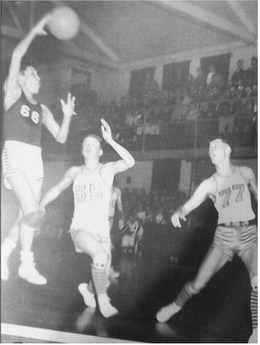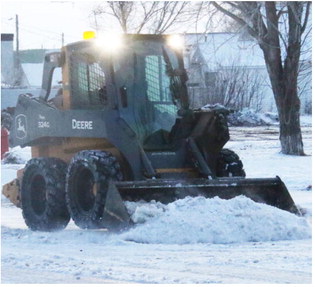Wolf Point’s History: Bear Skin Spectacular, Indian Lad


Montana State College cowboy Victor Bearskin was certain he wouldn’t die in a rodeo arena. After all, he was a calf roper, not a bronc or bull rider. But, on the dangerous Montana highways in the 1950s? There was a chance. He had lost relatives and friends on the Big Sky State’s roads. The day after he won a 1950 calf roping contest in Wolf Point, seven Poplar youths were seriously injured in a one-vehicle accident just east of Wolf Point. A few months prior, seven MSC students were killed and one seriously injured in a one-vehicle accident near Chestnut (a former coal mining community) on the Bozeman Pass.
Two were members of the Bobcat football team. His Assiniboine (Nakoda, Nakona) elders reminded Bearskin that, “Tomorrow is never promised.” Especially with Bearskin’s driving style. He pushed his vehicles like his horse, Spade. Just like his ancestors, galloping their ponies into bison herds or enemy Blackfeet throngs. And for a blink of time — whether it be in the saddle, on the diamond, or on a dusty football field on Moccasin Flats, Bearskin fashioned dreamlike memories for those who were lucky enough to witness the eye-catching specter. And those that heard the heartbreaking news on May 24, 1954, were reminded of their vivid recollections – the striking speed and dexterity, the surprising strength and power, the sparkle of athletic brilliance. Their memories are now ghosts. Beautiful spirits never to be recaptured.
At 5 a.m., Sunday, May 23, 1954, Montana State College’s beloved freshman rodeo star, Victor Bearskin, crashed his vehicle at the same Chestnut – on the same treacherous Bozeman Pass. He died a day later in Bozeman Deaconess Hospital. The Monday afternoon edition of The Bozeman Chronicle stated, “The car which Bearskin apparently was driving went out of control and rolled over, the highway patrol reported.” The Chronicle continued, “Kenneth Griggs of Bozeman, who told officers he was asleep in the back seat of the car... was not injured. The car was demolished. Bearskin and Griggs were returning from Wolf Point, in order that the MSC freshman could participate in the [MSC] college rodeo [in Belgrade on Sunday].” The Associated Press stated that Bearskin “...was a champion roper and top point getter for the MSC team.”
Vic Bearskin — Snake Hipping and Skidding
When Bearskin enrolled at MSC in the fall of 1953, his goal wasn’t to look and sound smart at Greek cocktail parties. Instead, he sought competition — to join the fray of sport. At Wolf Point High School, he was part of Bob Lowry’s teams that went on championship benders in both football and basketball. Lowry’s “pack of strays” battered Eastern B football opponents. As a passer, Bearskin went to the sky, tossing precision lobs to fellow Wolves. Against the intimidating Forsyth Dogies for the 1950 Eastern B crown, The Bainville Democrat cooed: “Bearskin uncorked a beautiful pass [for a touchdown]” and a Wolf Point victory.
As a fleet halfback, he was “spectacular,” according to Malta’s Phillip County News. The Bainville Democrat reported, “Vic Bearskin snakehipped his way off tackle to cross the goal line” in an easy win over Fairview.
The Plentywood Herald marveled at Bearskin’s jaw-dropping athleticism during a “mudfest” and “mudbowl” caused by “driving rain and high wind” on Wolf Point’s gumbo field located on Moccasin Flats. As other players slipped due to the “greasiness” of the field, Bearskin kept his feet. On the first play of the game, “Bearskin... skidded over his own left guard... and went the distance for the touchdown.” Not only was Bearskin agile, but he was also powerful. Malta Mustang Ted Kelly remembered when he tried to tackle Bearskin. The calf roper rammed his helmet “right in my belly,” leaving an excruciating — and lingering — memory.
Concerning basketball, Wolf Point was like a fox in the henhouse — winning two state titles and two third places during Bearskin’s high school years. Competing in the Snake Pit at the 1952 state tournament in Anaconda, The Montana Standard gushed: “Bear Skin, spectacular Indian lad who seemed to be everywhere and doing the right thing all the time, rallied Wolf Point [to victory].” Bearskin had aged out for the 1952-53 basketball year but still competed in football in the fall of 1952. He was basketball manager for 1952-53.
When asked recently about Bearskin, Jim Haugen, former Montana High School Association executive director, said, “I wish you could have seen him play basketball. He could shoot.” Haugen, playing against Wolf Point as a Sidney Eagle, remembered Bearskin as a gifted ball handler and defender — “an interceptor” of basketballs.
Roping in front of 10,000 “paid admissions” over three days Victor Bearskin was raised a few miles west of Wolf Point, in an Assiniboine community known as Prairie Chicken Hill (Shiyo Baha). This collection of log cabins and huts housed his Prairie Chicken Clan of the Wadopana (Canoe Paddlers) Band of Assiniboine. With the buffalo gone, 700 Assiniboine surrendered at the sub-agency in Wolf Point on the Fort Peck Indian Reservation in 1883. Due to a brutal first winter with limited road access, 300 starved to death. It was only the beginning of the suffering, as some government officials tried to sentence the Assiniboine to a permanent underclass status on a reservation that was eventually opened to homesteading. Greed knew no boundaries. The Assiniboine’s inexperience with laws, combined with a few corrupt officials’ calculated trickery, led to drawing the short straw. It was a shocking, new way of life. But the Assiniboine rose up. They faced the challenge. To support their people, the men and boys continued their horse culture ways by working on ranches in the area. Some eventually established their own successful ranches and farms.
To be acknowledged as a valued cowhand, accomplished roping was a necessary notch in the plainsmen’s rite of passage. For fun, cowboys roped anything and everything — from calves and goats to an occasional lynx. In 1925, it was reported in The Wolf Point Herald that an Indian farmer by the name of Growing Four Times, “sighted the animal [lynx] and gave chase [on the prairie] and succeeded in dropping the loop of his lariat over its head and bringing it safely into captivity.”
Victor’s father, Claude (Blue Cloud), was one of the esteemed Native cowboys on the reservation. He and his Assiniboine and Sioux friends entered the initial Wolf Point Stampede Rodeo in 1921 — the oldest rodeo in Montana. Within a decade, the Stampede was drawing the best in the world. Over the years, Claude Bearskin and his Native peers consistently placed in several unique and dangerous events such as the cowboy relay, pony race, wild cow milking, and the half-mile free-for-all.
Still a high schooler in 1952, Vic Bearskin entered his second consecutive Stampede against the world’s best calf ropers. Bearskin roped all three days in front of 10,000 “paid admissions”— with 3,500 fans packed at the grounds on Sunday, cheering on their beloved roper. He missed his calf, but based on the media hype, the neophyte Bearskin was a crowd favorite.
Fighting for His Life at Bozeman Deaconess Enrolling in MSC in the fall of 1953, and standing only five-foot eight, Bearskin made it through multiple cuts to make the 1953-54 Bobkitten junior varsity basketball club. He also competed in fall rodeo and won a wild cow milking contest in Idaho. This was during a time when freshmen were denied entry into varsity competition but were allowed to participate in a sub-varsity or exhibition context. Rodeo points were not officially tallied for freshmen, but in the case of Bearskin, his remarkable talent was noted.
During the 1950s, the MSC rodeo club included both state and national champions. They also sought the top competition, including inviting the finest from the National Intercollegiate Rodeo Association to their home rodeo in May 1954 in Belgrade. Attending that fateful weekend were some of the best cowboys and cowgirls in the nation. Leading the way was top-ranked Colorado A& M (now Colorado State University) with Bobby Schild, an eventual national champion in bareback and saddle bronc. The Rams also presented Brad Tate, at the time ranked second in the national allaround while participating in calf roping and bulldogging. To add to the competition, the Idaho Vandals sported Howard “Hell-For-Leather” Harris, who would end up the national all-around champion for 1954.
Saturday’s competition was rained out, so there would be two shows on Sunday. Victor Bearskin missed both. He was fighting for his life in Bozeman Deaconess Hospital.
“I remember when it happened”
Although limited to sub-varsity competition, Bearskin was such an accomplished roper that, for several years after his death, the fastest MSC roper would be acknowledged with the Bearskin Memorial Trophy at the Bobcats’ annual rodeo. Future steer wrestling national champion, Vic Small won in 1956. Bill Nauman from Conrad received the award in 1957. In the years after Bearskin’s death, it was bestowed by Vic’s parents, Claude and Minnie Bearskin themselves — traveling over 400 miles from Wolf Point to grant the honor.
Bearskin’s death stunned Montana fans. “I remember when it happened,” recalled Haugen, who graduated from Sidney High School in 1954. “I really do.” Haugen recollects multiple state media outlets covering the Bearskin tragedy.
Future professional bull rider, LeeRoy Mann, just a Wolf Point eighth grader at the time, remembers viewing Bearskin’s body at the local funeral home, just across the street from the Liberty Theater. The viewing was part of the four-day traditional Assiniboine wake. Bearskin had such an influence on reservation youth that four Wolf Pointers qualified for the 1956 National High School Rodeo finals in Reno, Nev. The Wolf Point cowboys hopped in an orange and white 1956 Ford Victoria two-door hardtop. Hitched behind them was a horse trailer with Victor’s mount, Spade — by this time, a mystical vestige of the Bearskin legend. Riding Spade, Earl Babcock claimed third place in the nation in bulldogging. Sitting in second place in bull riding on the second day was Larry Granbois of Turtle Mountain Chippewa heritage. Granbois was on his way to a possible national title when he “got hooked by a horn” after completing his second ride. He ended up in a Reno hospital and was unable to compete on day three. Mann remembers the 2,500-mile round trip and connects Bearskin’s influence and Spade’s companionship as a special life experience.
At a place they call the “Tall Trees” They buried Vic Bearskin in the treeless Chicken Hill Cemetery — just north of the Missouri River bottom of the Fort Peck Reservation. He rests with 167 Assiniboine, Sioux, Metis and Chippewa- Cree people. Some of the community’s names have vanished — Swings the Thigh, First Sound, Pointing Iron. Gone are the original houses of the Prairie Chicken Clan.
One home remains — next to some auto and agricultural boneyards. If Victor had passed a few decades earlier, they would have raised his body into the high limbs of the cottonwoods in a place they called the “Tall Trees.” Mourning that day was Bearskin’s 10-year-old nephew, Ken Ryan (His Black Horse). Ryan would go on to be a leader of the Assiniboine people. He eventually became a pipe keeper and Medicine Lodge leader. He would be instrumental in founding Fort Peck Community College and helping to preserve the Assiniboine language. Ryan was awarded an honorary doctorate in humane letters by the University of Montana in 1995. He was proud to call Victor Bearskin his uncle. Ryan was also active in gathering information for his uncle’s rightful place in the Montana Indian Athletic Hall of Fame in 2016.
Precious Memories: “Tomorrow is Never Promised” Important to Bearskin’s legacy is that he was wellliked. He was a natural unifier of the state’s sports fans. For example, in a high school that was 80 percent non-Native, he was fondly called “Hot Toddy.” The class of 1955 dedicated their annual — The Fang — to him. Although a fierce competitor, it wasn’t like Bearskin’s opponents were begging for 10 uppercuts. Instead, they respected him. In the 1954 MSC annual, Bearskin sits for the rodeo club’s photo. He is in the middle of smiling cowboys and cowgirls. In a college that had few students of color, he remains striking, confident and beaming. The rodeo club was on a sugar-high of possibilities, with many talented underclassmen, including a favorite, Hot Toddy Bearskin.
In 1997, Marvin Presser wrote in his 350-page book, Wolf Point: A City of Destiny,
“One of 1954’s saddest moments occurred in late May. Victor Bearskin was killed in an automobile accident... near Bozeman... [Bearskin] won the friendship and acclaim of his teammates, coaches, opposing coaches and... Montana sports fans… The whole community mourned his death.” During Bearskin’s athletic tenure, another local historian, Sid Peterson, considered Bearskin to be the best Wolf Point athlete of all time, just ahead of another Assiniboine, Everett Redstone.
Just for a flicker of time, strangers from different races and opposing schools were united, cheering “the Indian lad” on. With a magical flip of the rope in a Bozeman rodeo arena, or a deadeye swish in Anaconda’s Snake Pit, or a long touchdown on a sunny day on Moccasin Flats — powdered dust rising and falling behind his cleats, Vic Bearskin created phantom visions for fans and opponents alike.
Vic Bearskin galloping Spade across the dry prairie. The wind at their back. Dust rising and falling, forever. Precious memories of Victor Bearskin, rising and falling forever.




